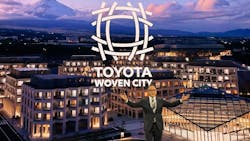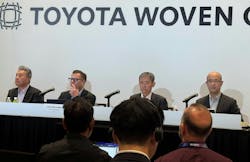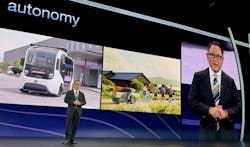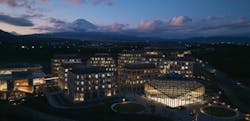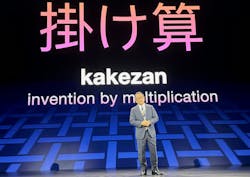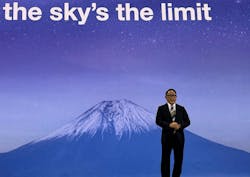LAS VEGAS—It figures that Toyota, for years, has announced its plans for the future here at the massive Consumer Electronics Show in Vegas, a city built on glitz, gambling, and playing the odds. Only Toyota’s game doesn’t come with concrete odds, and we don’t know how much the project has and will cost.
Smart Industry's Crystal Ball 2025 Report: A look into manufacturing technology
In 2018 at CES, Toyota President Akio Toyoda announced the company’s intention to become a “mobility company” and embrace a larger vision outside automobile development and manufacturing. Toyota would concern itself with things like the mobility services platform developed by subsidiary Toyota Connected, electric vehicles (EVs), and autonomous technologies.
At CES 2020, Toyoda revealed plans for Woven City (the name of the campus refers to Toyota’s founding in the early 1900s as an automated loom manufacturer), a prototype town of the future that would host R&D into advanced technologies like those mentioned in 2018, as well as robotics and smart homes.
Woven City is far from the first corporate-imagined city of the future.
Walt Disney in the 1960s conceived of an Experimental Prototype Community of Tomorrow, or EPCOT, that today relegates science to less than half the space while Disney IP-themed rides spread across the park.
This year at CES, Toyoda in a keynote address announced the completion of the first phase of construction at Woven City, which is located in Susono City, Shizuoka Prefecture, Japan, at the base of Mount Fuji.
Full video of Toyota President Akio Toyoda's keynote address at CES
“This year, residents will begin moving in as we slowly bring Woven City to life. … Our population will eventually grow to around 2,000 people and will include Toyota employees and their families, retired people, retailers, visiting science, industry partners, entrepreneurs, academics and of course, their pets,” Toyoda said.
Later on Jan. 6, Toyota Motor Corp. Executive VP Hiroki Nakajima, Woven by Toyota Chief Technology Officer John Absmeier, Woven by Toyota CEO Hajime Kumabe, and Kenta Kon, CFO and director of Woven by Toyota, briefed U.S. and international media on details of progress at Woven City and the company's evolving vision for the campus.
More than a research incubator
Toyoda added during his keynote that the city will focus on four key research areas: the mobility of people, goods, information and energy, with the city serving as a testbed for everything.
“Homes in the Woven City will eventually serve as test sites for future technologies, such as in-home robotics to assist with daily life,” he continued.
The big question: What’s the business plan? Does Toyota Motor expect Woven City to generate profits?
“Well, maybe not, but that's OK, because as global citizens, I believe Toyota has a responsibility to invest in our collective future, to share what we've learned with others, and support new ideas that benefit the planet and its people. And that more than anything else, is why we created Woven City,” Toyoda said.
Woven by Toyota still wants profits
Woven by Toyota CEO Kumabe, at the media roundtable following the keynote, sang a slightly different tune.
“We do not agree with that. We would like to create additional values through Woven City, a new revenue stream,” he said.
Episode 4 of (R)Evolutionizing Manufacturing: The Art of the Possible and The Art of the Practical
The Woven City initiative includes an accelerator program for startups and individual entrepreneurs. We would expect that either Woven by Toyota or Toyota Motor could profit from companies that spin out of the program, either through equity stakes of profit-sharing. According to Kumabe, however, no plans currently exist for capital tie-ups or anything similar.
Nakajima, the executive VP at Toyota Motor, called Woven City a “mobility test course,” adding that the testing campus creates good mobility products, exactly the same as how a good test course for cars shortens development times and creates better vehicles.
“Toyota Motor itself has gone through eight incremental improvements in kaizen and a continuous stream of transformations, but to be honest with you, Toyota Motor is such a large company, it takes a lot of time and effort to transform itself,” Nakajima added.
See also: New report reflects optimism among manufacturers mixed with some caution
“So what we're looking for from Woven City is to serve as a catalyst for us to appropriately change going forward. … If they're not close enough, then the change really isn't going to take place at Toyota. If they're too close, then that too isn't conducive to that change,” he continued.
Cooperative altruism vs. product development
Toyota says the inventors invited to join Woven City commit to working “for someone other than themselves,” but the first announced inventors for Woven City and the work they intend to pursue sound more like typical product development.
Take DyDo Drinco Inc., a manufacturer of soft drinks and beverages. According to Toyota, DyDo will research “new value through innovative vending machine concepts.”
- Nissin Food Products Co. Ltd., known for its freeze-dried ramen products, will “create and evaluate food environments to inspire new food cultures.”
- UCC Japan Co. Ltd., whose operating companies deal with coffee manufacturing and sales, intends to “explore the potential value of coffee through futuristic café experience.”
- Daikin Industries Ltd., the fourth announced inventor and a manufacturer of air conditioning products, intends to “test pollen-free spaces” and “personalized functional environments.”
- Zoshinkai Holdings Inc., that provides education services including correspondence and classroom modalities, plans to “leverage data to realize innovative educational methods and new learning environments.”
Those certainly read like research projects pursuant to serving the direct economic interests of the companies in question—i.e., working not just for someone other than themselves.
However, Toyota certainly exercised discernment in who so far has gotten invites to take up residence at Woven City. After the CES 2020 announcement, Toyota received over 6,000 individual inquiries. Only five companies made the cut.
Best of 2024: SI looks back at our favorite features
“Although the motivation for each of the first five companies varies, we were able to reach an agreement with those companies as we believe we all share a ‘for others’ mindset and a desire to ‘contribute to the future.’ For example, in the case of Nissin … it will explore the new possibilities of food in the extension of healthy life expectancy,” a Toyota spokesperson told IndustryWeek, a sister brand to Smart Industry.
Woven City won’t distract from autonomy research
Toyoda during his keynote called out autonomous driving technology as a focus for Woven City, and Woven by Toyota CTO Absmeier explained later the relationship between the campus and Toyota’s existing autonomy tech.
“Woven City is a core part of Toyota's mobility transformation, alongside Arene, which is our advanced software development platform, as well as our autonomous driving technologies. Where Woven City will focus on expanding mobility from the perspective of the city and everyday life, Arene and our autonomous driving technologies will do so from the perspective of the car, laying the foundation for the next generation software defined Toyota vehicle,” Absmeier said.
See also: Partners in IoT that made perfect sense
Kumabe said that Toyota already develops technology to improve autonomous cars’ precision. Woven by Toyota, on the other hand, concerns itself with creating environments conducive to autonomous driving and safety.
“In this city, we will have many people living there, and also we have better control of infrastructure. So by coordinating cars, people and infrastructure together, we should be able to develop autonomous driving cars and we can achieve the goal of zero casualty of traffic accidents,” Kumabe said.
When asked whether Woven City’s holistic approach to autonomous driving, versus beginning in a more streamlined way like the testing currently conducted by Waymo in Phoenix or San Francisco would delay Toyota’s development of the technology, Absmeier said Woven City presents a complementary approach.
The AI trap: Why manufacturers fail without the right data
“We're not stopping development to wait for the city. The city offers the opportunity…to integrate with people and society once we're ready to test those vehicles in the city. We are developing autonomous driving (AD) and advanced driver assistance systems (ADAS) in partnership with Toyota to deploy to mass production as early as this year,” Absmeier said.
Calculating ROI with no metrics
“Bettering mankind” has no value for an ROI calculation. If Toyota Motor doesn’t have profit targets in place, how can the company assess the success (or failure) of the Woven City project?
“Woven City, this test course, is something that is going to change its form and its shape over time, at some times to make it easier to test and demonstrate. It is incomplete and ever evolving,” said Kon, the CFO for Woven by Toyota.
“Using these test scores, we'll be looking at what kind of value we can generate out of [Woven City], what kind of products come out of this, and how what we provide to customers leads toward transformation of automobiles," Kon continued. "And five years, 10 years down the road, if these functionalities become a normal part of the life of the residents living there, that's a good thing, and something that we can call success.”
Podcast featuring Dennis Scimeca: Which industrial technologies are really worth the investment?
Again, there are lots of precedents for this kind of thinking. Xerox’s Palo Alto Research Center in Silicon Valley, in 1969, took on the mission of envisioning the office of the future. Researchers there developed the graphic user interface now ubiquitous on Apple IOS and Microsoft operating system-based computers, the computer mouse and object-oriented programming. The main technology that Xerox kept for itself, instead of giving away to computer companies, was the laser printer.
“We are going to have many inventors living here, and the inventors won't be coming from any one industry, but rather a variety of different industries," Kon added.
"Alongside them, we will have people from Toyota living there, too, people who have a great deal of expertise and knowledge in manufacturing craftsmanship. And so when you think about having this variety of different people living together in this same space, working on development, at this point in time we really don't know what kind of innovations that is going to lead to, what kind of reactions will come out of that that mix.”
The opportunity cost for mobility
Phase 1 of Woven City occupies about 50,000 square meters. Phase 2, which began in May and is planned for completion at the end of 2025, will double the size of the current campus. The final footprint should occupy about 708,000 square meters (equivalent to about 135 football fields), Kumabe said. Woven City also features an underground logistics system (like what Disney runs under its theme parks, incidentally).
See also: DAPs help keep employees engaged in digital transformation projects
Executives declined to comment on how much Phase 1 has cost the company, and so we cannot make even an educated guess as to the total cost of the project. We do know, however, that Chairman Toyoda invested personal funds into Woven City. He clearly thinks Toyota placed a smart bet. Now, time to see whether the odds favor the new community of the future.
“We believe that by combining Toyota's strength with those from different industries we'll be able to create new value, new products and new services we could never achieve on our own. We think of it as invention by kakezan, or invention by multiplication. Because when it comes to what's possible, when you work together, the sky's the limit.”
About the Author
Dennis Scimeca
Dennis Scimeca is a veteran technology journalist with particular experience in vision system technology, machine learning/artificial intelligence, virtual and augmented reality, and interactive entertainment. He has experience writing for consumer, developer, and B2B audiences with bylines in many highly regarded specialist and mainstream outlets.
His home base is IndustryWeek, where he covers the continuing expansion of new technologies into the manufacturing world and the competitive advantages gained by learning and employing these new tools. He also seeks to build connections between manufacturers by sharing the stories of their challenges and successes employing new technologies. If you would like to share your story with IndustryWeek, please contact him at [email protected].
